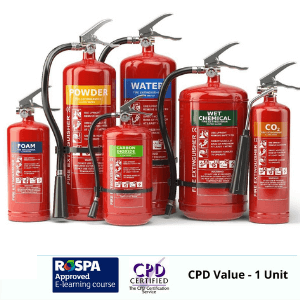Fire Extinguisher Training
Current legislation, The Regulatory Reform (Fire Safety) Order 2005, applies to all workplaces regardless of the number of employees. It requires employers to provide adequate training in fire awareness to all staff so everyone knows how to respond in an emergency. This includes the ability to assess fire safety risk, comprehensively covered in this fire extinguisher training course.
Our online fire safety training courses will help to identify and the risks that fire presents. This course provides training in the use of different types of fire extinguishers in addition to understanding of the class rating these types of fires belong to.
The location of fire extinguishers should be easily found. Companies must ensure that each fire extinguisher is appropriate to the fire risk for the location it is in. Fire marshals, and others who are put in place to manage fire safety risk, should always have the appropriate fire extinguisher training for the fire risk involved.
The most reliable way to protect lives is to get people away from the fire. This should always be the first consideration and action. Tackling a fire is complex as there are many variables and we do not recommend that you tackle a fire as the first line of action.
If, after having raised the alarm, you find it necessary to tackle the fire, you need to know the four ways fire can spread. These are direct burning, convection, conduction, and radiation. Using an extinguisher to tackle a fire is only effective during the direct burning stage.
Understanding the Risks in Tackling a Fire
Our course takes the learner through the hazards to be aware. These include the risk of electrocution that conducting fluids such as water can cause when coming into contact with the mains electricity supply.
Other potential risks include
- making the fire worse,
- causing an explosion
- accelerating the spread of fire.
- Becoming cut off from the exit by fire
- Being overcome by smoke or fumes
Fire Extinguisher Training – Assessing Fire Safety Risk
It’s essential to properly assess the situation prior to taking action.
- Are you totally confident in what you’re about to face?
- Do you know how to handle the fire safety risk you are faced with?
- Can you recall your training and the use of extinguishers?
- Do you know what has caused the fire to start?
- Do you know what materials the fuel that’s burning?
- Are you sure you have the right extinguisher for the situation?
- Do you know how to properly prepare and deploy the extinguisher?
Types of Fire Extinguishers and when they are used
The range of fire extinguishers available are water, foam, CO2, dry powder, wet chemical and fire blankets. Realistically in any one workplace you’ll never need or have so many different choices. If you work in an office for instance, then you’ll probably only have water, foam and CO2 extinguishers at your disposal.
Each type of extinguisher is colour coded. The course describes the material each type of fire extinguisher is used on and what what makes it effective to extinguish fires. For instance, CO2 is used on fires that involve electricity and works by emitting a blast of carbon dioxide to remove the oxygen for the fire.
How to Use each type of fire extinguisher
The course takes the learner through the steps to follow when using each type of fire extinguisher. You will be taken through, in detail, the mechanics of each and how to prepare the extinguisher prior to using it.
Depending on which extinguisher you are using, you will learn which part of the fire you should aim at. For instance, with dry powder, you aim the nozzle towards the nearest part of the fire and move the jet in rapid sideways movements to cover the burning area.
| Course Content | Module |
| Fire Extinguishers | 1 |
| Pre-Engagement Action | 2 |
| Using a Fire Extinguisher | 3 |
Fire Extinguisher Training


CPD Units ‘1’
Course Assessment
Online assessment for this fire extinguisher training is carried out by a series of multiple choice questions. Candidates must answer 70% of the questions correctly to pass each module. We advise you to complete each module and answer the question before moving on to the next module. This provides a better learning experience because you will need to have knowledge from earlier modules to understand some of the material in the later modules. For those who complete the course successfully, a PDF certificate of the award is sent directly to your inbox. Hard copies of the award are available on request. The course takes 25 minutes of training to complete. This is course content only and does not cover the time it takes to answer questions.


